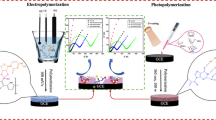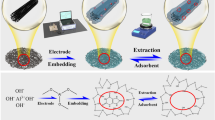Abstract
A molecularly-imprinted electrochemiluminescence sensor was constructed for the determination of fenpropathrin (FPT) by molecular imprinting technology. In this sensing platform, the introduction of CdS@MWCNTs significantly enhanced the initial ECL signal of the luminol-O2 system. Specifically, MWCNTs was used as a carrier to adsorb more CdS, in which CdS acted as a co-reaction promoter for luminescence. Molecularly imprinted polymer (MIP) containing specific recognition sites of FPT was used as the material for selective recognition. With increasing amount of FPT the ECL signal decreased. Under the optimum conditions, the ECL response was linearly related to the logarithm of FPT concentration. The developed ECL sensor allowed for sensitive determination of FPT and exhibited a wide linear range from 1.0 × 10− 10 mol L− 1 to 1.0 × 10− 6 mol L− 1. The limit of detection was 3.3 × 10− 11 mol L− 1 (S/N = 3). It can be used for the detection of FPT in vegetable samples.





Similar content being viewed by others
References
Park J, Park SK, Choi YH (2019) Environmental pyrethroid exposure and diabetes in U.S. adults. Environ Res 172:399–407. https://doi.org/10.1016/j.envres.2018.12.043
Fang L, Jia M, Zhao H, Kang L, Shi L, Zhou L, Kong W (2021) Molecularly imprinted polymer-based optical sensors for pesticides in foods: recent advances and future trends. Trends Food Sci Technol 116:387–404. https://doi.org/10.1016/j.tifs.2021.07.039
Li X, Zeng D, Liao YY, Tsunoda M, Zhang YX, Xie X, Wang R, Li RS, Hu WT, Deng SM, Song YT (2020) Magnetic nanoparticle-assisted in situ ionic liquid dispersive liquid-liquid microextraction of pyrethroid pesticides in urine samples. Microchem J 159:105350. https://doi.org/10.1016/j.microc.2020.105350
Zhou QX, Zhang XG, Xie GH (2011) Preconcentration and determination of pyrethroid in-secticides in water with ionic liquid dispersive liquid-phase microextraction in combination with high performance liquid chromatography. Anal Methods 3:356–361. https://doi.org/10.1039/c0ay00570c
Kretschmann A, Cedergreen N, Christensen JH (2015) Measuring internal azole and pyrethroid pesticide concentrations in Daphnia magna using QuEChERS and GC-ECD-method development with a focus on matrix effects. Anal Bioanal Chem 408:1055–1066. https://doi.org/10.1007/s00216-015-9197-x
Qian H, Hu L, Liu CR, Wang HZ, Gao HX, Zhou WF (2018) Determination of four pyrethroid insecticides in water samples through membrane emulsification-assisted liquid-liquid microextraction based on solidification of floating organic droplets. J Chromatogr A 1559:86–94. https://doi.org/10.1016/j.chroma.2018.04
Lawal A, Wong RCS, Tan GH, Abdulra’uf LB (2019) Determination of pesticide residues in fruit and vegetables by high-performance liquid chromatography-tandem mass spectrometry with multivariate response surface methodology. Anal Lett 52:231–248. https://doi.org/10.1080/00032719.2018.1459655
Guerrero-Esteban T, Gutiérrez-Sánchez C, Martínez-Periñán E, Revenga-Parra M, Pariente F, Lorenzo E (2021) Sensitive glyphosate electrochemiluminescence immunosensor based on electrografted carbon nanodots. Sens Actuators B 330:129389. https://doi.org/10.1016/j.snb.2020.129389
Mahmoudpour M, Torbati M, Mousavi MM, de la Guardia M, Nazhad Dolatabadi JE (2020) Nanomaterial-based molecularly imprinted polymers for pesticides detection: recent trends and future prospects. TRAC Trends Anal Chem 129:115943. https://doi.org/10.1016/j.trac.2020.115943
Uzun L, Turner APF (2016) Molecularly-imprinted polymer sensors: realising their potential. Biosens Bioelectron 76:131–144. https://doi.org/10.1016/j.bios.2015.07.013
Wackerlig J, Schirhagl R (2015) Applications of molecularly imprinted polymernanoparticles and their advances toward industrial use: a review. Anal Chem 88:250–261. https://doi.org/10.1021/acs.analchem.5b03804
Capoferri D, Álvarez-Diduk R, Del Carlo M, Compagnone D, Merkoçi A (2018) Electrochromic molecular imprinting sensor for visual and smartphone-based detections. Anal Chem 90:5850–5856. https://doi.org/10.1021/acs.analchem.8b00389
Hu Y, He YC, Peng ZC, Li YC (2020) A ratiometric electrochemiluminescence sensing platform for robust ascorbic acid analysis based on a molecularly imprinted polymer modified bipolar electrode. Biosens Bioelectron 167:112490. https://doi.org/10.1016/j.bios.2020.112490
Tian L, Wu KX, Hu Y, Wang Y, Zhao YJ, Chen RZ, Lu J (2020) A molecularly imprinted electrochemiluminescence nanoprobe based on complexes consisting of CdTe and multiwall carbon nanotube for sensitive determination of clenbuterol. Microchim Acta 187:358. https://doi.org/10.1007/s00604-020-04319-2
Pirot M, Omer SM K (2022) Surface imprinted polymer on dual emitting MOF functionalized with blue copper nanoclusters and yellow carbon dots as a highly specific ratiometric fluorescence probe for ascorbic acid. Microchem J 182:107921. https://doi.org/10.1016/j.microc.2022.107921
Li H, Xie T, Shi D, Jin J, Xie C (2016) Enhanced electrochemiluminescence of luminol at the gold nanoparticle/carbon nanotube/electropolymerised molecular imprinting composite membrane interface for selective recognition of triazophos. Int J Environ Anal Chem 96:1300–1311. https://doi.org/10.1080/03067319.2016.1250261
Liu GY, Ling J, Xie HZ, Li JP (2022) Ultrasensitive molecularly imprinted electrochemiluminescence sensor based on enzyme-encapsulated liposome-linked signal amplification for trace analysis. Sens Actuators B 355:131263. https://doi.org/10.1016/j.snb.2021.131263
Nasiri KY, Sun SG (2020) A novel MIP-ECL sensor based on RGO-CeO2NPs/Ru(bpy)32+-Chitosan for ultratrace determination of trimipramine. J Mater Chem B. https://doi.org/10.1039.D0TB01666G
Khan MS, Zhu WJ, Ali A, Ahmad SM, Li XJ, Yang L, Wang YG, Wang H, Wei Q (2019) Electrochemiluminescent immunosensor for prostate specific antigen based upon luminol functionalized platinum nanoparticles loaded on graphene. Anal Biochem 566:50–57. https://doi.org/10.1016/j.ab.2018.11.010
Sha H, Wang Y, Zhang Y, Ke H, Xiong X, Jia N (2018) Enzyme-free ECL immunesensor based on PbS nanocrystals for highly sensitive detection of alpha fetoprotein. Sens Actuators B 277:157–163. https://doi.org/10.1016/j.snb.2018.09.006
Wu FF, Zhou Y, Zhang H, Yuan R, Chai YQ (2018) Electrochemiluminescence peptide-based biosensor with hetero-nanostructures as coreaction accelerator for the ultrasensitive determination of tryptase. Anal Chem 90:2263–2270. https://doi.org/10.1021/acs.analchem.7b04631
Zhang X, Tian L, Wu KX, Sun Z, Wu Q, Shan XY, Zhao YJ, Chen RZ, Lu J (2022) High sensitivity electrochemiluminescence sensor based on the synergy of ZIF-7 and CdTe for determination of glucose. Microchem J 177:107254. https://doi.org/10.1016/j.microc.2022.107254
Zhao YJ, Tian L, Zhang X, Sun Z, Shan XY, Wu Q, Chen RZ, Lu J (2022) A novel molecularly imprinted polymer electrochemiluminescence sensor based on Fe2O3@Ru(bpy)32+ for determination of clenbuterol. Sensors and Actuators B: Chemical, l350: 130822. https://doi.org/10.1016/j.snb.2021.130822
Arab N, Fotouhi L, Salis A (2021) Electrosynthesised CdS@ZnS quantum dots decorated multi walled carbon nanotubes for analysis of propranolol in biological fluids and pharmaceutical samples. Microchem J 168:106453. https://doi.org/10.1016/j.microc.2021.106453
Li ZP, Dong WX, Du XY, Wen GM, Fan XJ (2020) A novel photoelectrochemical sensor based on g-C3N4@CdS QDs for sensitive detection of Hg2+. Microchem J 152:104259. https://doi.org/10.1016/j.microc.2019.104259
Liang H, Song DD, Gong JM (2014) Signal-on electrochemiluminescence of biofunctional CdTe quantum dots for biosensing of organophosphate pesticides. Biosens Bioelectron 53:363–369. https://doi.org/10.1016/j.bios.2013.10.011
Sun Z, Lu J, Zhang X, Shan XY, Wu Q, Li C, Li HL, Yang SN, Tian L (2023) Electrospun nanofibres containing Zn-MOF for electrochemiluminescent determination of fenpropathrin residues in fruit juices. Food Chem 405:134950. https://doi.org/10.1016/j.foodchem.2022.134950
Chen PP, Liu Z, Liu JH, Liu HB, Bian WW, Tian D, Xia FQ, Zhou CL (2020) A novel electrochemiluminescence aptasensor based CdTe QDs@NH2-MIL-88(Fe) for signal amplification. Electrochim Acta 354:136644. https://doi.org/10.1016/j.electacta.2020.136644
Haghighi B, Tavakoli A, Bozorgzadeh S (2015) Cathodic electrogenerated chemiluminescence of luminol on glassy carbon electrode modified with cobalt nanoparticles decorated multi-walled carbon nanotubes. Electrochim Acta 154:259–265. https://doi.org/10.1016/j.electacta.2014.11.175
Xu JJ, Zhang RR, Liu CX, Sun AL, Chen J, Zhang ZM, Shi XM (2020) Highly selective electrochemiluminescence sensor based on molecularly imprinted-quantum dots for the sensitive detection of cyfluthrin. Sensors 20:884. https://doi.org/10.3390/s20030884
Oliveira JFA, Milão TM, Araújo VD, Moreira ML, Longo E, Bernardi MIB (2011) Influence of different solvents on the structural, optical and morphological properties of CdS nanoparticles. J Alloys Compd 509:6880–6883. https://doi.org/10.1016/j.jallcom.2011.03.171
Wang ML, Sun YN, Yang ML (2018) CdS QDs amplified electrochemiluminescence of N,S co-doped graphene quantum dots and its application for pb(II) determination. Chem Lett 47:44–47. https://doi.org/10.1246/cl.170846
Karadurmus L, Ozcelikay G, Armutcu C, Ozkan A S (2022) Electrochemical chiral sensor based on molecularly imprinted polymer for determination of (1S, 2S)-pseudoephedrine in dosage forms and biological sample. Microchem J 181:107820. https://doi.org/10.1016/j.microc.2022.107820
Acknowledgements
This work was financially supported by Jilin Education Foundation (JJKH20230905KJ).
Author information
Authors and Affiliations
Corresponding author
Ethics declarations
Declaration of competing interest
The authors declare that they have no known competing financial interests or personal.
relationships that could have appeared to influence the work reported in this paper.
Additional information
Publisher’s Note
Springer Nature remains neutral with regard to jurisdictional claims in published maps and institutional affiliations.
Electronic supplementary material
Below is the link to the electronic supplementary material.
Rights and permissions
Springer Nature or its licensor (e.g. a society or other partner) holds exclusive rights to this article under a publishing agreement with the author(s) or other rightsholder(s); author self-archiving of the accepted manuscript version of this article is solely governed by the terms of such publishing agreement and applicable law.
About this article
Cite this article
Wu, Q., Tian, L., Shan, X. et al. A molecule-imprinted electrochemiluminescence sensor based on CdS@MWCNTs for ultrasensitive detection of fenpropathrin. Microchim Acta 191, 269 (2024). https://doi.org/10.1007/s00604-024-06296-2
Received:
Accepted:
Published:
DOI: https://doi.org/10.1007/s00604-024-06296-2




